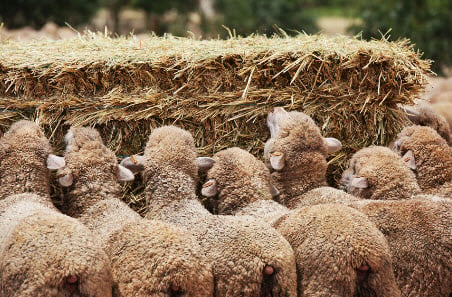Feed planning pays off
04 October 2017

Producers feeding drought or frost-affected crops to livestock – either as standing crops, fodder or grain – need to understand what makes it a success or a failure, according to livestock nutrition consultant Hamish Dickson.
"A lot of time and money has been wasted over the years turning failing crops into poor quality hay or silage," he said.
"If you don't understand the components to getting it right, such as timing and quality management, you can end up with a half-baked product from what started as a high value crop. It can cost you money in lost livestock production because the job wasn’t done properly."
Hamish, from South Australian-based AgriPartner Consulting, also suggests producers with frost damage assess the impact on pastures, as protein loss and slow spring recovery can mean the nutritional requirements of livestock are not being met and supplementation may be needed.
When it comes to failed crop decision making, Hamish recommends producers consider the following:
If the crop is to be grazed:
- Timing: How soon can livestock be put on to the crop and how does that affect feed quality?
- Livestock class: What are the feed demands of different classes of livestock and which will be best suited to grazing that crop?
- Future management: Will the crop be spray topped before grazing and what impact does that have on quality and withholding periods?
- Nutritional quality: A feed test is essential to determine whether or not the animal’s nutritional requirements can be met when grazing the crop.
- Animal health: Understand the life stage of the crop and its impact (i.e. consumption of grain formed in the head can lead to other health problems). Be aware of issues such as pulpy kidney and acidosis. Nitrate poisoning is also a risk on crops such as canola and oats.
If the crop is to be turned into hay or silage:
- Treatment: What bests suits your enterprise? What type of hay or silage can you utilise or sell?
- Capabilities: Are contractors or skilled operators available to make the hay or silage?
- Nutritional quality: A feed test is essential to determine whether or not the animal’s nutritional requirements can be met when consuming the hay or silage.
- Utilisation: Match the quality and volume of end product to the livestock class which will benefit the most. It is also important to understand your capacity to market or handle fodder.
- Management: Consider risks with managing stored fodder such as hay stack fires.
If the crop goes through to harvest for feed quality grain:
- Livestock class: What are the feed demands of different classes of livestock and which will be best suited to consuming the grain?
- Preparation: Imprint feeding is essential with all supplementary grains. Talk to a specialist before introducing new feeds to an animal's diet. The risk of acidosis is high in sheep and cattle and can be reduced with gradually introducing the grain and seeking veterinary advice on preparing animals.
- Nutritional quality: A feed test is essential to determine whether or not the animal’s nutritional requirements can be met when consuming the grain.
- Feed budget: Understand an animal's energy and protein requirements to formulate an appropriate ration.
- Supplementation: Grain and low quality pasture or crop stubbles may not entirely meet an animal's needs and mineral supplementation may be required. Calcium supplementation is considered essential when grazing cereal crops and stubbles.
Contact
Hamish Dickson, AgriPartner
Principal Livestock Consultant
E: hamish@agripartner.com.au
Resources
Frost-affected crops: assess your options
Making More From Sheep Healthy and Contented Sheep module which covers supplementation, animal health and energy and protein requirements.
More Beef from Pastures has modules on pasture utilisation, meeting market specifications and animal health.
MLA has a range of tools and calculators covering pasture budgets, animal nutrition and feed.


